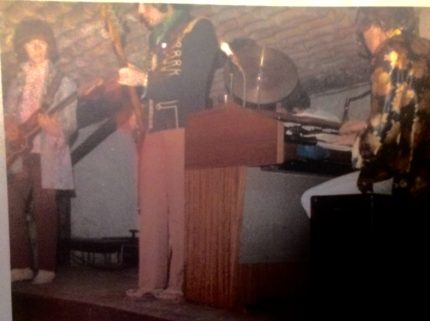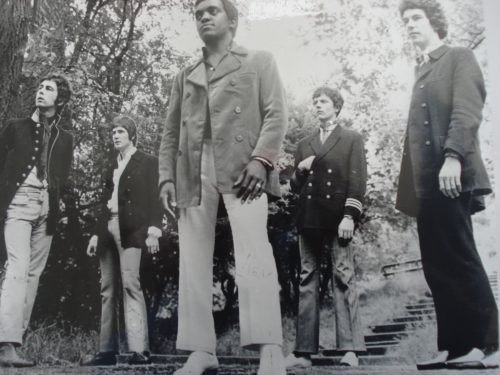
Kenny Bernard – lead vocals
Alan Griffin – lead guitar
Colin Pullen – bass
Phil Lanzon – keyboards
Roy Manderson – drums
Hailing from South London Cats Pyjamas released two highly inventive yet extremely rare and collectable 45s for the Direction label during 1968. The quintet’s music bridged psychedelia and progressive rock with hints of soul/R&B and both releases were notable for their top notch production and the superlative musicianship of its players.
Trinidad-born singer Kenny Bernard had first come to prominence with R&B outfit The Wranglers during 1963. Formed around the Lewisham area, the previous year, the group subsequently recorded a lone single for the Pye label, “The Tracker”, which was released in August 1965. Around the same time, the musicians were captured live at the Ad Lib Club in Leicester Square for a rare acetate that years later found its way into the hands of Mark Lamarr. The DJ passed the live tracks to the Acid Jazz label, which released the recordings as the Kenny Bernard & The Wranglers Live ’65 CD in 2011.
When The Wranglers splintered a few months later, Bernard stayed with Pye Records and recorded a cache of stylish R&B/soul-inspired singles during 1966 and 1967, none of which troubled the charts. However, as Bernard noted in his autobiography, You Came Into My Life, he found going solo a daunting experience and missed working with a band on stage.
One night (the most plausible date is sometime in June 1967), the singer was out at the Scotch of St James nightclub in Mayfair with his old friend Pete Gage, former guitarist in Geno Washington & The Ram Jam Band, when he heard that South London group, The Loose Ends, were looking for a singer to front the band.
Originally from Bexley Heath in Kent, The Loose Ends had cut a couple of singles for Decca Records with singer Alan Marshall at the helm before undergoing a major overhaul in October 1966, which left the singer with the name. Marshall’s manager Bryan Mason then linked him with Croydon outfit, The Subjects, who featured guitarist Alan Griffin, keyboard player Phil Lanzon and drummer Roy Manderson.
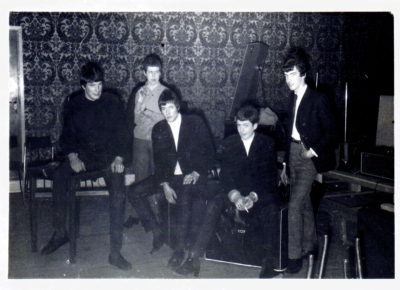
Over the next few months, The Loose Ends’ manager also started to bring in musicians from Bexley band, Bob ‘N’ All to replace outgoing musicians. These included new bass player Colin Pullen and second singer Bob Saker. However, shortly before taking up a residency at the Bang Bang Club in Milan in mid-January 1967, first Roy Manderson and then Alan Griffin dropped out to make way for new recruits. Both, however, kept in touch with Phil Lanzon.
Fast forward to early March and The Loose Ends were back in London, and with Alan Griffin back in the fold, the group performed at the Scotch of St James and the Speakeasy. Shortly after a gig at the Central London Polytechnic on 15 April, where they opened for The Savoy Brown Blues Band, singers Alan Marshall and Bob Saker took up soul legend Otis Redding’s offer to fly to the US to record at Fame Studios in Muscle Shoals.
Left without their two front men, The Loose Ends, who’d brought Roy Manderson back on board after his replacement Tony Glyde had left to join first The Fenmen and then Simon K & The Meantimers, put out feelers for another singer. With Marshall and Saker out of the picture, the musicians also decided to revamp themselves as Cats Pyjamas.
After spending a month or so working up a stage set with Kenny Bernard, Colin Pullen recalls that the group’s debut gig took place at a college in Epsom, Surrey, which quite possibly could have been nearby Ewell Technical College Refectory, a popular local venue for up and coming bands to perform at.
Over the next few months, Cats Pyjamas gigged fairly incessantly, and one of the band’s most notable gigs during this period was an appearance at the Starlight Room at Boston Gliderdrome in September with The Original Drifters. Pullen also recalls playing in Bournemouth’s Winter Gardens during the first few months of the group’s existence.
However, in early December, Cats Pyjamas secured a crucial deal with the Rik Gunnell Agency, which most likely was brokered by their manager Pete Gage, who’d co-written one of the band’s standout songs, “Virginia Water” with Kenny Bernard and had previous dealings with the agency during his time with The Ram Jam Band.
Selected gigs:
According to the Reading Evening Post, 12 August, Kenny Bernard plays at the Bag O’Nails around this time (and this would be with Cats Pyjamas).
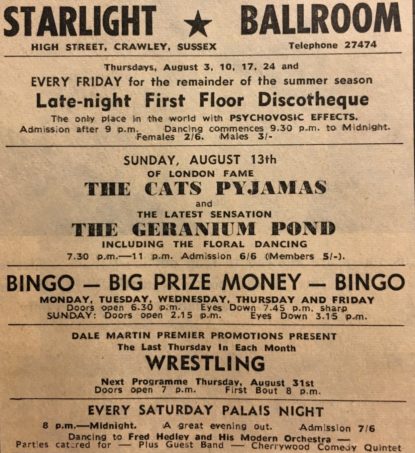 13 August 1967 – Starlight Ballroom, Crawley, West Sussex with The Geranium Pond (Crawley Advertiser)
13 August 1967 – Starlight Ballroom, Crawley, West Sussex with The Geranium Pond (Crawley Advertiser)

30 September 1967 – Starlight Room, Boston Gliderdrome, Boston, Lincolnshire with Original Drifters and The Magic Roundabout (Lincolnshire Standard)
7 October 1967 – Clouds, Derby (Derby Evening Telegraph)
22 October 1967 – Elm Hotel, Southend, Essex (Southend Standard)

4 November 1967 – The Place, Hanley, Staffordshire with Scots of St James (Evening Sentinel)

11 November 1967 – Cesar’s Club, Bedford, Bedfordshire with Geranium Pond (Bedfordshire Times)
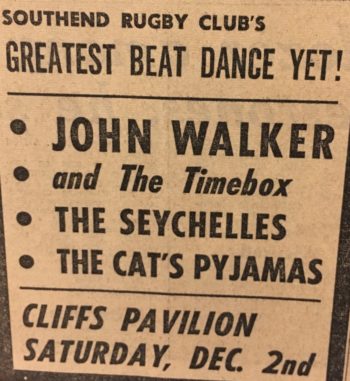
2 December 1967 – Cliff’s Pavilion, Southend, Essex with John Walker and The Timebox and The Seychells (Southend Standard)
2 December 1967 – Luton Boys Club, Luton, Bedfordshire with Tramline (Evening Post: Hemel Hempstead)
8 December 1967 – The Place, Hanley, Staffordshire with The Wafer Board (Evening Sentinel)
The link-up with the Rik Gunnell Agency brought in steady stream of live work and importantly gave the band a regular spot to shine at the agency’s top Soho club, the Bag O’Nails on Kingley Street. It also led to a recording deal with the Direction label and, that same month, the musicians recorded a superb version of Jeff Barry, Ellie Greenwich and Phil Spector’s “Baby, I Love You”, originally a top 30 US hit for The Ronettes in 1963, at Olympic Studio’s in Barnes.
To this listener’s ears, however, it is the flip, the Pete Gage/Kenny Bernard penned “Virginia Water” that is the more impressive recording. A psych/prog-rock masterpiece, the song, named after the Surrey commuter town, benefits greatly from Mervyn Conn’s excellent production and demonstrates the inventiveness of a band that is only a few months old.
Alan Griffin sets the scene with a sizzling “nosediving” guitar effect, which is soon buried in the rhythm section’s intricate, syncopated bass and percussion lines. The action then cuts back to the guitarist, who interjects with a series of strident riffs, signalling the arrival of Phil Lanzon’s majestic, prog-rock Hammond fills. As the brooding atmosphere threatens to spill over, Kenny Bernard joins the fray with his distinctive, powerful and soulful lead vocals.
The single, when released on 26 January 1968, should have been a massive hit, but instead sank without a trace. Perhaps “Virginia Water” would have fared better had it been promoted as the A-side but then again the band’s unique style, marrying psych-progressive rock with soul influences was probably far too inventive and dare I say it, “ahead of its time” to meet the narrow demands of the pop charts. Needless to say, breaking into top echelons of the charts was practically an impossibility anyway given The Beatles, The Rolling Stones and others’ virtual stranglehold.
Interestingly, “Virginia Water” caught the attention of Scottish progressive-rock band, Writing on The Wall, who later recorded the track under an “unknown” title for their Power of The Picts LP.
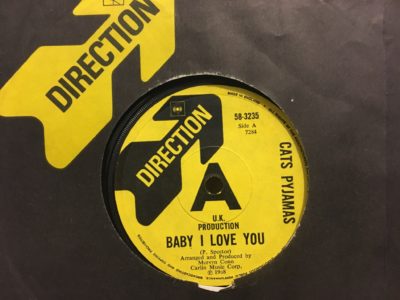
Selected gigs:
15 December 1967 – Sibyllas, Swallow Street, central London (Rik Gunnell Agency bookings)
16 December 1967 – Bag O’Nails, Kingley Street, Soho, central London (Rik Gunnell Agency bookings)

18 December 1967 – Kettering Working Men’s Club, Kettering, Northamptonshire (Rik Gunnell Agency bookings/Northamptonshire Evening Telegraph)
19 December 1967 – Pantiles, Bagshot, Surrey (Rik Gunnell Agency bookings)
22 December 1967 – Roaring 20’s, Carnaby Street, Soho, central London (Rik Gunnell Agency bookings)
23 December 1967 – Bag O’Nails, Kingley Street, Soho, central London (Rik Gunnell Agency bookings)
24 December 1967 – Beachcomber, Nottingham (Rik Gunnell Agency bookings)
26 December 1967 – Pantiles, Bagshot, Surrey (Rik Gunnell Agency bookings)
28 December 1967 – Klooks Kleek, West Hampstead, north London (Rik Gunnell Agency bookings)
29-30 December 1967 – Bag O’Nails, Kingley Street, Soho, central London (Rik Gunnell Agency bookings)
31 December 1967 – Rasputin’s, New Bond Street, central London (Rik Gunnell Agency bookings)
2 January 1968 – Bag O’Nails, Kingley Street, Soho, central London (Rik Gunnell Agency bookings)
5 January 1968 – “Big C”, 1 Camp Road, Farnborough, Hampshire (Rik Gunnell Agency bookings)
6 January 1968 – Cliff’s Pavilion, Southend (Rik Gunnell Agency bookings)
9 January 1968 – Bag O’Nails, Kingley Street, Soho, central London (Rik Gunnell Agency bookings)
11-12 January 1968 – Sibyllas, Swallow Street, central London (Rik Gunnell Agency bookings)
13 January 1968 – Marquee, Wardour Street, Soho, central London with The Gods (Tony Bacon’s Book: London Live)

13-14 January 1968 – Il Grotto, Ilford, Essex (Rik Gunnell Agency bookings/Redbridge & Ilford Recorder)
15 January 1968 – Bag O’Nails, Kingley Street, Soho, central London (Rik Gunnell Agency bookings)
17 January 1968 – Sibyllas, Swallow Street, central London (Rik Gunnell Agency bookings)
19 January 1968 – Pantiles, Bagshot, Surrey (Rik Gunnell Agency bookings)
20 January 1968 – Margon’s College, King’s Road, Chelsea, southwest London (Rik Gunnell Agency bookings)

21 January 1968 – Alex’s Disco, Salisbury, Wiltshire (Rik Gunnell Agency bookings/Salisbury Journal)
25-26 January 1968 – Sibyllas, Swallow Street, central London (Rik Gunnell Agency bookings)
27 January 1968 – Holborn College of Law, Red Lion Square, central London (Rik Gunnell Agency bookings)
28 January 1968 – Kettering Working Men’s Club, Kettering, Northamptonshire with Deuce Coupe (Rik Gunnell Agency bookings)
29 January 1968 – Bag O’Nails, Kingley Street, Soho, central London (Rik Gunnell Agency bookings)
1 February 1968 – RAF Wyton, Huntingdon, Cambridgeshire (Rik Gunnell Agency bookings)
2 February 1968 – Sibyllas, Swallow Street, central London (Rik Gunnell Agency bookings)
3 February 1968 – Luton Boys Club, Luton, Bedfordshire (Rik Gunnell Agency bookings)
5 February 1968 – Bag O’Nails, Kingley Street, Soho, central London (Rik Gunnell Agency bookings)
9-10 February 1968 – Bag O’Nails, Kingley Street, Soho, central London (Rik Gunnell Agency bookings)
10 February 1968 – Cliffs Pavilion, Southend, Essex with The Merseys and North Sea Bubble (Southend Standard)
13-15 February 1968 – Rasputin’s, New Bond Street, central London (Rik Gunnell Agency bookings)
16 February 1968 – Pantiles, Bagshot, Surrey (Rik Gunnell Agency bookings)
17 February 1968 – Cliffs Pavilion, Southend, Essex with Peter Green’s Fleetwood Mac (Rik Gunnell Agency bookings)

18 February 1968 – Carlton Club, Erdington, West Midlands with The Amboy Dukes (Birmingham Evening Mail/Rik Gunnell Agency bookings)
20 February 1968 – Bag O’Nails, Kingley Street, Soho, central London (Rik Gunnell Agency bookings)
23 February 1968 – Boat 27, Sibyllas, central London (Rik Gunnell Agency bookings)
24 February 1968 – Ceasar’s, Bedford, Bedfordshire (Rik Gunnell Agency bookings)
28 February 1968 – Rasputin’s, New Bond Street, central London (Rik Gunnell Agency bookings)
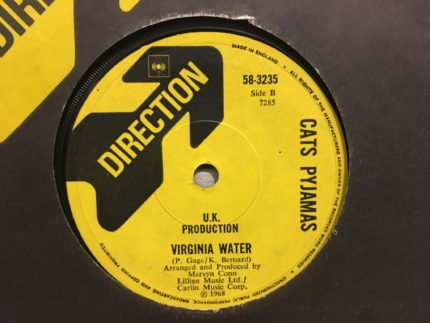
2 March 1968 – Bag O’Nails, Kingley Street, Soho, central London (Rik Gunnell Agency bookings)
3 March 1968 – Beachcomber, Nottingham (Rik Gunnell Agency bookings)
Undeterred by the chart failure of their debut 45, Cats Pyjamas returned to Olympic Studios in Barnes with Mervyn Conn to record a follow up release. According to Rik Gunnell’s agency bookings, the group spent two days recording (4 and 5 March).
Colin Pullen remembers that The Steve Miller Band were recording tracks for Children of The Future in the studio next door and when Cats Pyjamas had finished their session they watched the San Francisco group at work.
During the sessions, Cats Pyjamas recorded two new Kenny Bernard songs, “Camera Man” and “Houses”. Bernard would revisit the pedestrian “Houses” in later years and but here the rest of the band give the song a semi-acoustic treatment complete with progressive organ fills. To this listener’s ears, the track wouldn’t sound out of place on The Small Faces’ Autumn Stone or Family’s Music From a Doll’s House. Far better is the raving Mod/prog cross-over “Camera Man” with its infectious chorus and stomping, driving beat.
Like “Virginia Water”, “Camera Man” demonstrates just how innovative Cats Pyjamas could be in the studio; unfortunately the group’s second outing would follow its predecessor into obscurity. The tragedy is that the group never got the opportunity to cut more material towards an LP.
Selected gigs:
7 March 1968 – Bag O’Nails, Kingley Street, Soho, central London (Rik Gunnell Agency bookings)
8 March 1968 – Meridan Youth Club, Royston, Hertfordshire (Rik Gunnell Agency bookings)
9 March 1968 – Locarno, Swindon, Wiltshire (Rik Gunnell Agency bookings)
11-12 March 1968 – Bag O’Nails, Kingley Street, Soho, central London (Rik Gunnell Agency bookings)
 16 March 1968 – Gaiety Ballroom, Ramsey, Cambridgeshire with The Friction (Rik Gunnell Agency bookings/Cambridgeshire Times)
16 March 1968 – Gaiety Ballroom, Ramsey, Cambridgeshire with The Friction (Rik Gunnell Agency bookings/Cambridgeshire Times)
17 March 1968 – King Alfred, Bellingham, southeast London (Rik Gunnell Agency bookings)
20 March 1968 – Bag O’Nails, Kingley Street, Soho, central London (Rik Gunnell Agency bookings)
23 March 1968 – Central School of Art, Southampton Row, central London (Rik Gunnell Agency bookings)
24 March 1968 – Foseco Sports & Social Club, Drayton Manor, Tamworth, Staffordshire (Rik Gunnell Agency bookings)
25-27 March 1968 – Rasputin’s, New Bond Street, central London (Rik Gunnell Agency bookings)
25-27 March 1968 – Bag O’Nails, Kingley Street, Soho, central London (Rik Gunnell Agency bookings)
29 March 1968 – Pantiles, Bagshot, Surrey (Rik Gunnell Agency bookings)

30 March 1968 – Twickenham College, Twickenham, west London with Mystie Romance (Melody Maker)
3 April 1968 – Cue Club, Paddington, central London (Melody Maker)
5 April 1968 – Ministry of Health, Alexander Fleming House, Elephant & Castle, London (Rik Gunnell Agency bookings)
 6 April 1968 – Stax Club, Cirencester, Gloucestershire with The Purple Barrier (Rik Gunnell Agency bookings)
6 April 1968 – Stax Club, Cirencester, Gloucestershire with The Purple Barrier (Rik Gunnell Agency bookings)
7 April 1968 – Bull’s Head, Yardley, West Midlands (Rik Gunnell Agency bookings)
9 April 1968 – Bag O’Nails, Kingley Street, Soho, central London (Rik Gunnell Agency bookings)
11 April 1968 – Cue Club, Paddington, central London (Melody Maker)
13 April 1968 – White Tiles Disco, Swindon, Wiltshire (Rik Gunnell Agency bookings)
14-15 April 1968 – Bag O’Nails, Kingley Street, Soho, central London (Rik Gunnell Agency bookings)
19-20 April 1968 – Rasputin’s, New Bond Street, central London (Rik Gunnell Agency bookings)
 21 April 1968 – Tower Ballroom, Great Yarmouth, Norfolk (Rik Gunnell Agency bookings/Yarmouth Mercury)
21 April 1968 – Tower Ballroom, Great Yarmouth, Norfolk (Rik Gunnell Agency bookings/Yarmouth Mercury)
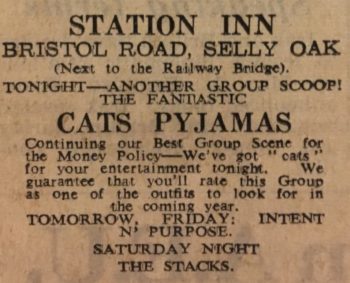
25 April 1968 – Station Hotel, Selly Oak, West Midlands (Rik Gunnell Agency bookings/Birmingham Evening Mail)
26 April 1968 – Bolero Club, Wednesbury, West Midlands (Rik Gunnell Agency bookings)
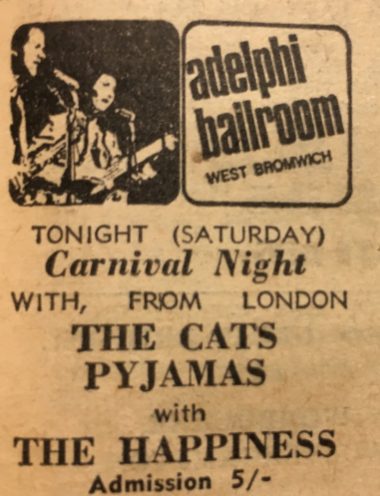
27 April 1968 – Adelphi Ballroom, West Bromwich, West Midlands with The Happiness (Rik Gunnell Agency bookings/Express & Star)
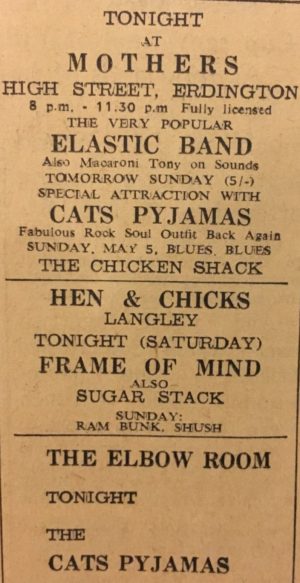
27 April 1968 – Elbow Room, Aston, West Midlands (Rik Gunnell Agency bookings/Birmingham Evening Mail)
28 April 1968 – Carlton Ballroom, Erdington, West Midlands (Rik Gunnell Agency bookings)
29 April-3 May 1968 – Rasputin’s, New Bond Street, central London (Rik Gunnell Agency bookings)
4 May 1968 – Brave New World, Eastney, Hampshire (Website: http://michaelcooper.org.uk/C/birdcage.htm)
9-10 May 1968 – Bag O’Nails, Kingley Street, Soho, central London (Rik Gunnell Agency bookings)
11 May 1968 – Cue Club, Paddington, central London (Rik Gunnell Agency bookings)
12 May 1968 – Bull’s Head, Yardley, West Midlands (Rik Gunnell Agency bookings)
13 May 1968 – Bag O’Nails, Kingley Street, Soho, central London (Rik Gunnell Agency bookings)
17 May 1968 – Rasputin’s, New Bond Street, central London (Rik Gunnell Agency bookings)

18 May 1968 – Dandylion Club, Cross Hands Inn, Brockworth, Gloucestershire (Gloucester Citizen/Rik Gunnell Agency bookings)
20 May 1968 – Yeoman, Stafford, Staffordshire (Rik Gunnell Agency bookings)
21-22 May 1968 – Bag O’Nails, Kingley Street, Soho, central London (Rik Gunnell Agency bookings)
24 May 1968 – Rasputin’s, New Bond Street, central London (Rik Gunnell Agency bookings)
30-31 May 1968 – Bag O’Nails, Kingley Street, Soho, central London (Rik Gunnell Agency bookings)
Released on 24 May 1968, “Camera Man” c/w “Houses” was another creative step forward but all was not well within the band. As Bernard later admitted in his autobiography, the singer was increasingly coming to blows with the rest of the group, both musically and personally. A rare high point was a month-long residency at the Stones Club in Madrid during June where Cats Pyjamas took over from Carl Douglas & The Big Stampede.
Selected gigs:
June 1968 – Stones Club, Madrid, Spain (Rik Gunnell Agency bookings)
3 July 1968 – Hyde Park Hotel, Debs Ball, central London (Rik Gunnell Agency bookings)
4 July 1968 – Bag O’Nails, Kingley Street, Soho, central London (Rik Gunnell Agency bookings)
5 July 1968 – Rasputin’s, New Bond Street, central London (Rik Gunnell Agency bookings)
6 July 1968 – Bag O’Nails, Kingley Street, Soho, central London (Rik Gunnell Agency bookings)

7 July 1968 – King Alfred, Bellingham, southeast London (Rik Gunnell Agency bookings)
10 July 1968 – Elbow Room, Aston, West Midlands (Rik Gunnell Agency bookings)
11 July 1968 – Station Inn, Selly Oak, West Midlands (Rik Gunnell Agency bookings)
12 July 1968 – Bolero Club, Wednesbury, West Midlands (Rik Gunnell Agency bookings)
13 July 1968 – Mothers, Erdington, West Midlands (Rik Gunnell Agency bookings)
14 July 1968 – Bull’s Head, Yardley, West Midlands (Rik Gunnell Agency bookings)
15-19 July 1968 – Rasputin’s, New Bond Street, central London (Rik Gunnell Agency bookings)
20 July 1968 – Fellowship Inn, Bellingham, southeast London (Rik Gunnell Agency bookings)
26 July 1968 – Bag O’Nails, Kingley Street, Soho, central London (Rik Gunnell Agency bookings)
27 July 1968 – Petersfield Town Hall, Petersfield, Hampshire (Rik Gunnell Agency bookings)

3 August 1968 – Kirklevington Country Club, North Yorkshire (Rik Gunnell Agency bookings/Middlesbrough Evening Gazette)
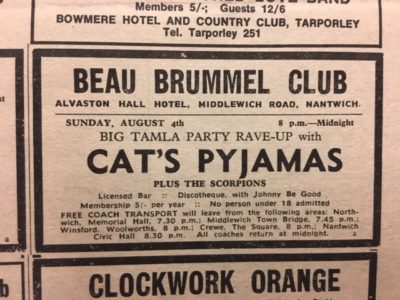
4 August 1968 – Beau Brummell Club, Alvaston Hall Hotel, Nantwich, Cheshire with The Scorpions (Rik Gunnell Agency bookings/Chester Chronicle)

5 August 1968 – Manor House Ballroom, Ipswich, Suffolk (Ipswich Evening Star) This is missing from Colin’s diary
9 August 1968 – Ship Hotel, Weybridge, Surrey (Rik Gunnell Agency bookings/Woking Herald)
10 August 1968 – Rasputin’s, New Bond Street, central London (Rik Gunnell Agency bookings)
12 August 1968 – Bag O’Nails, Kingley Street, Soho, central London (Rik Gunnell Agency bookings)
17 August 1968 – Swan Hotel, Yardley, West Midlands (Rik Gunnell Agency bookings)
23 August 1968 – Cue Club, Paddington, central London (Melody Maker)
24 August 1968 – Twisted Wheel, Manchester with Ben E King (Rik Gunnell Agency bookings)
25 August 1968 – Excel Bowling Alley, Middlesbrough, North Yorkshire (Rik Gunnell Agency bookings)
25 August 1968 – Cellar Club, Hartlepool, County Durham (Rik Gunnell Agency bookings)
30-31 August 1968 – Bag O’Nails, Kingley Street, Soho, central London (Rik Gunnell Agency bookings)
2 September 1968 – Bag O’Nails, Kingley Street, Soho, central London (Rik Gunnell Agency bookings)
5 September 1968 – John Gunnell’s Wedding Reception, 55, Jermyn St, central London (Rik Gunnell Agency bookings)
8 September 1968 – Surrey Rooms, Kennington, Oval, south London (Rik Gunnell Agency bookings)
11-13 September 1968 – Rasputin’s, New Bond Street, central London (Rik Gunnell Agency bookings)
14 September 1968 – Britannia Club, Nottingham (Rik Gunnell Agency bookings)
15 September 1968 – Pantiles, Bagshot, Surrey (Rik Gunnell Agency bookings)
20-21 September 1968 – Bag O’Nails, Kingley Street, Soho, central London (Rik Gunnell Agency bookings)
28 September 1968 – Rainbow Suite, Co-op, Birmingham (Rik Gunnell Agency bookings)
29 September 1968 – Bag O’Nails, Kingley Street, Soho, central London (Rik Gunnell Agency bookings)
4 October 1968 – Bag O’Nails, Kingley Street, Soho, central London (Rik Gunnell Agency bookings)
5 October 1968 – Fellowship Inn, Bellingham, southeast London (Rik Gunnell Agency bookings)
6 October 1968 – Bag O’Nails, Kingley Street, Soho, central London (Rik Gunnell Agency bookings)
11 October 1968 – Kingston College of Art, Kingston Upon Thames, southwest London (Rik Gunnell Agency bookings)
18-19 October 1968 – Rasputin’s, New Bond Street, central London (Rik Gunnell Agency bookings)
20 October 1968 – Bag O’Nails, Kingley Street, Soho, central London (Rik Gunnell Agency bookings)
21 October 1968 – Rasputin’s, New Bond Street, central London (Rik Gunnell Agency bookings)
25 October 1968 – Bag O’Nails, Kingley Street, Soho, central London (Rik Gunnell Agency bookings)

26 October 1968 – White Hart, Acton, west London (Rik Gunnell Agency bookings)
27 October 1968 – Mercer’s Arms, Swan Lane, Coventry, West Midlands (Rik Gunnell Agency bookings)
28-31 October 1968 – Playboy Club, Park Lane, central London (Rik Gunnell Agency bookings)
1-9 November 1968 – Playboy Club, Park Lane, central London (Rik Gunnell Agency bookings)
10 November 1968 – Swan Hotel, Yardley, West Midlands (Rik Gunnell Agency bookings)

16 November 1968 – El Grotto, Ilford, east London (Redbridge & Ilford Recorder) Missing from Colin’s diary
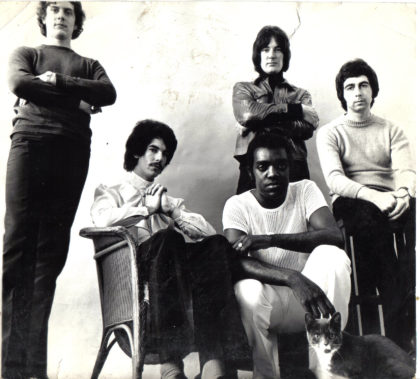
Having returned to the UK after working in Madrid for a month during June 1968, tensions between Kenny Bernard and the rest of the band continued to grow and following some final gigs for Rik Gunnell in mid-November, the singer parted ways to resume a solo career.
Cats Pyjamas stuck together a bit longer but sometime in 1969 Colin Pullen left. Around November of that year, remaining members Alan Griffin, Phil Lanzon and Roy Manderson joined Geno Washington and worked as his Ram Jam Band until the spring of 1970. Griffin remained with the singer when he put together a new version that year.
Phil Lanzon, however, maintained the greatest profile over the succeeding years, later working with Grand Prix, Chris Spedding and Sweet among others before joining Uriah Heep in 1986 with whom he continues to play.
Huge thanks to Colin Pullen (who kindly shared the Rik Gunnell Agency booking list), Alan Griffin and Phil Lanzon for providing information about the band.
Copyright © Nick Warburton. All Rights Reserved. No part of this article may be reproduced or transmitted in any from or by any means, without prior permission from the author.

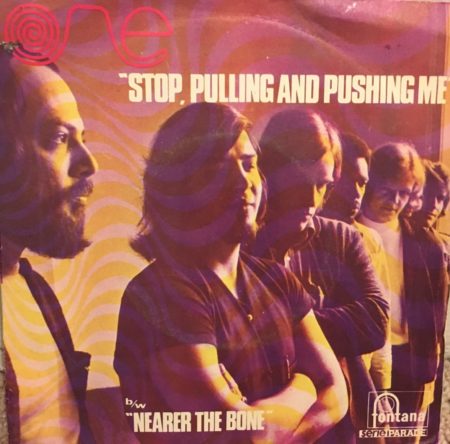
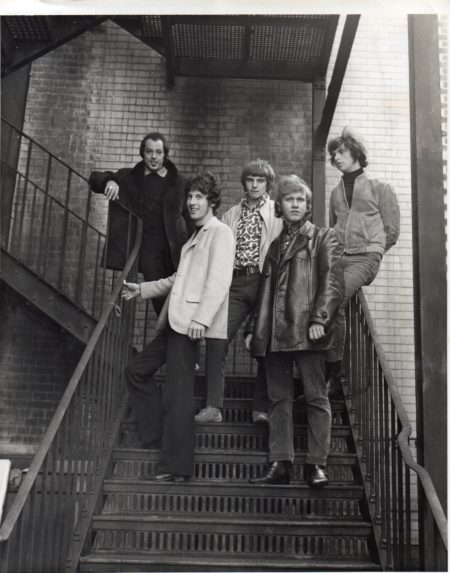
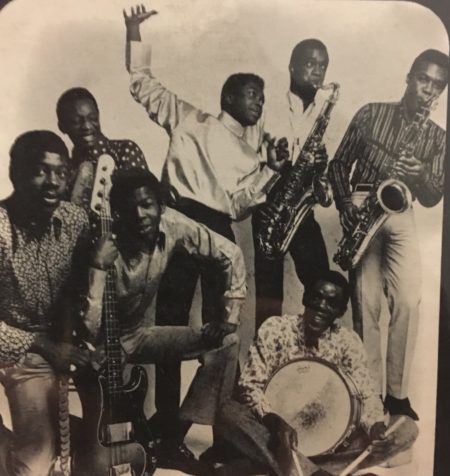
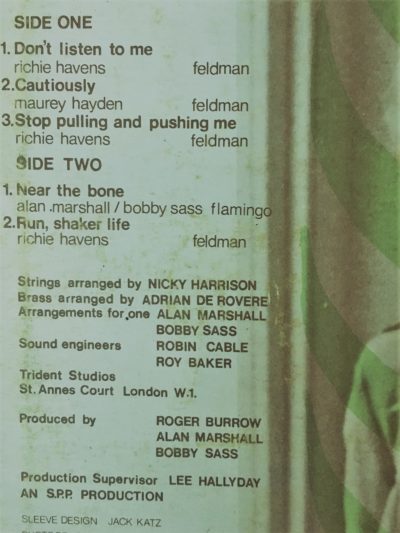 Production was split between the band’s manager Roger Burrow and Alan Marshall and Bobby Sass, working with sound engineers Robin Cable and Roy Baker. Production supervision meanwhile was handled by Lee Hallyday, who’d recently recorded his brother Johnny’s self-titled LP in France. According to several band members, the sessions at Trident’s studios also featured Alan Marshall’s former band mate from The Loose Ends and Happy Magazine, Peter Kirtley, who provided lead guitar on several cuts.
Production was split between the band’s manager Roger Burrow and Alan Marshall and Bobby Sass, working with sound engineers Robin Cable and Roy Baker. Production supervision meanwhile was handled by Lee Hallyday, who’d recently recorded his brother Johnny’s self-titled LP in France. According to several band members, the sessions at Trident’s studios also featured Alan Marshall’s former band mate from The Loose Ends and Happy Magazine, Peter Kirtley, who provided lead guitar on several cuts.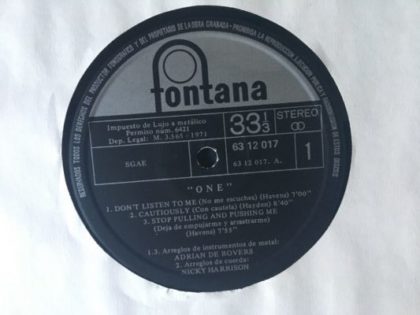 That may well be, but One’s storming cover of Havens’ “Don’t Listen To Me”, which opens the LP and third track, “Stop Pulling and Pushing Me” are inspired, extended workouts full of inventive playing and powerful instrumental passages. The musicians also do justice to “Cautiously”, an atmospheric reading of the ballad written by Maurey Hayden, singer, stand-up comedian and wife of Lenny Bruce. Alan Marshall and Bobby Sass’s “Near The Bone”, the band’s lone contribution to the song-writing stakes is also noteworthy.
That may well be, but One’s storming cover of Havens’ “Don’t Listen To Me”, which opens the LP and third track, “Stop Pulling and Pushing Me” are inspired, extended workouts full of inventive playing and powerful instrumental passages. The musicians also do justice to “Cautiously”, an atmospheric reading of the ballad written by Maurey Hayden, singer, stand-up comedian and wife of Lenny Bruce. Alan Marshall and Bobby Sass’s “Near The Bone”, the band’s lone contribution to the song-writing stakes is also noteworthy.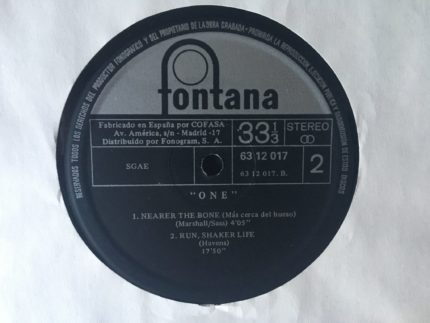 During March-April 1970, the musicians got to meet Stephen Stills, who was in London to record sessions for his first solo LP. It’s not clear who in the band made the initial contact. Marshall says that he used to leave the flat door open and musicians used to wander in. One strong possibility is Roger Burrow, who of course was a friend of Graham Nash’s. Alan Marshall, however, is pretty certain that it was Bobby Sass who ran into Stills.
During March-April 1970, the musicians got to meet Stephen Stills, who was in London to record sessions for his first solo LP. It’s not clear who in the band made the initial contact. Marshall says that he used to leave the flat door open and musicians used to wander in. One strong possibility is Roger Burrow, who of course was a friend of Graham Nash’s. Alan Marshall, however, is pretty certain that it was Bobby Sass who ran into Stills.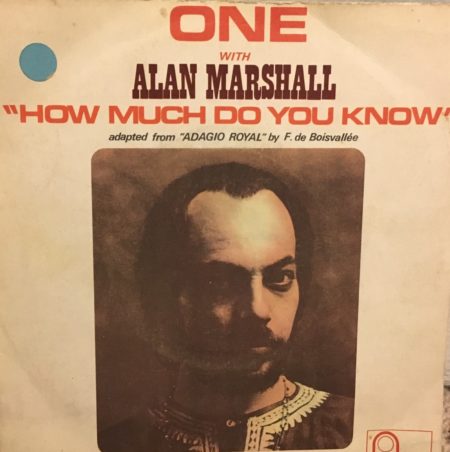 Interestingly, while One’s revolving door of personnel changes continued at pace, Fontana issued a French-only ‘45, ‘How Much Do You Know” (adapted from Adagio Royal by F de Boivallee), which was credited solely to Alan Marshall backed by One’s ‘Don’t Listen To Me”.
Interestingly, while One’s revolving door of personnel changes continued at pace, Fontana issued a French-only ‘45, ‘How Much Do You Know” (adapted from Adagio Royal by F de Boivallee), which was credited solely to Alan Marshall backed by One’s ‘Don’t Listen To Me”.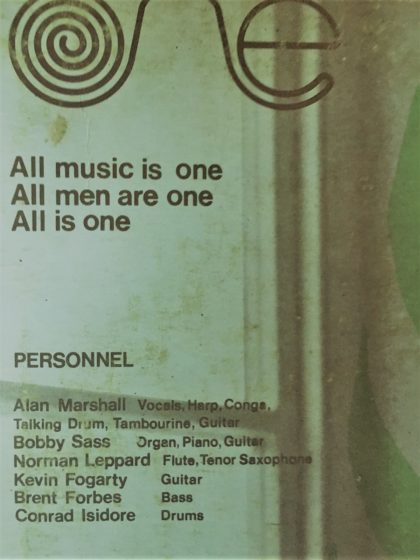 As for One, the group remains something of an obscurity. While the LP has been issued on CD by two different labels, neither appear to be official releases. Given the collectability of the record and the fact that a mint copy will probably fetch you close to £100, perhaps it’s time that the band was given a proper re-issue treatment, complete with detailed liner notes.
As for One, the group remains something of an obscurity. While the LP has been issued on CD by two different labels, neither appear to be official releases. Given the collectability of the record and the fact that a mint copy will probably fetch you close to £100, perhaps it’s time that the band was given a proper re-issue treatment, complete with detailed liner notes.
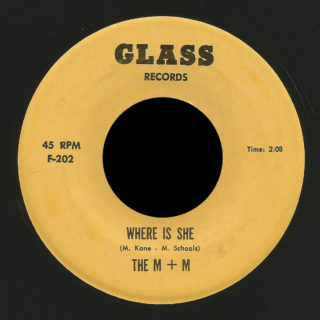
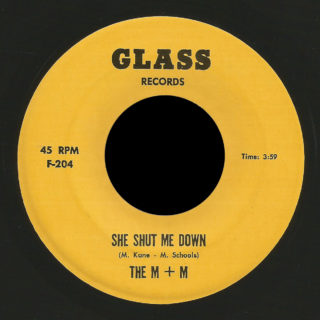
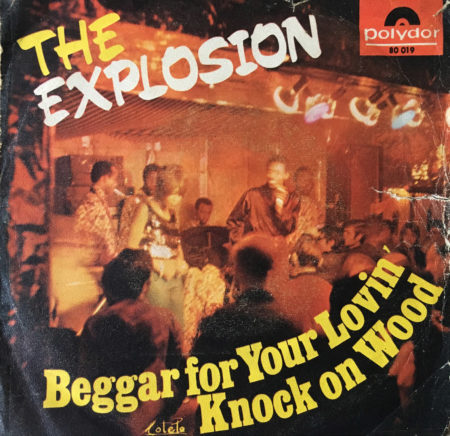 Babatunde Tony Ellis – lead guitar
Babatunde Tony Ellis – lead guitar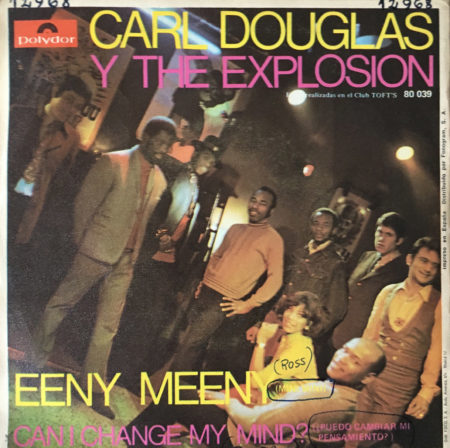 Douglas told me that the rest of The Explosion comprised musicians from Argentina, Colombia, France, Spain and Morocco. I also understand that Ellis, Simmonds and Evans were originally in a band called The Links who were regulars at Count Suckle’s Cue Club in Praed Street, Paddington.
Douglas told me that the rest of The Explosion comprised musicians from Argentina, Colombia, France, Spain and Morocco. I also understand that Ellis, Simmonds and Evans were originally in a band called The Links who were regulars at Count Suckle’s Cue Club in Praed Street, Paddington.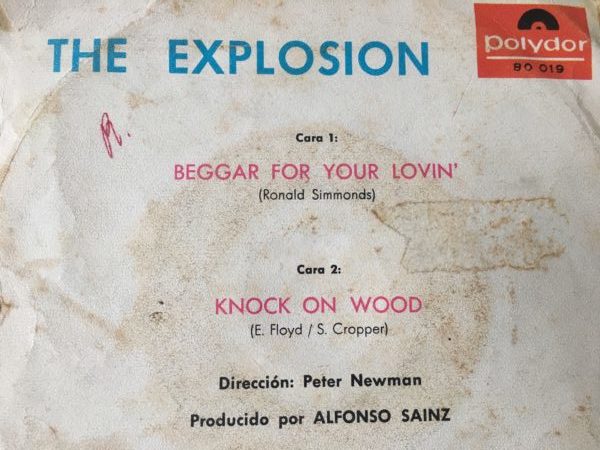
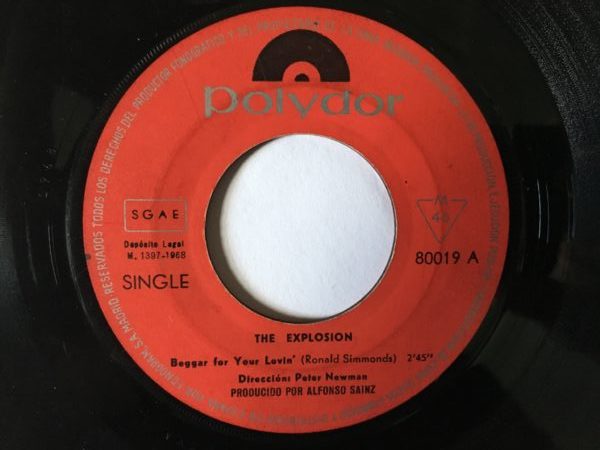
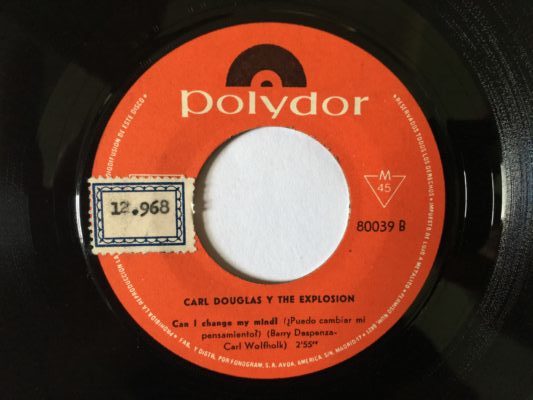

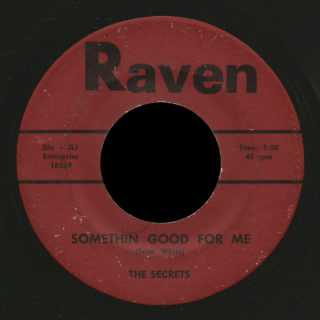
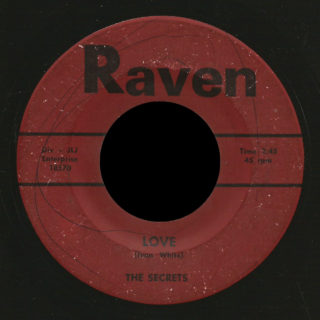

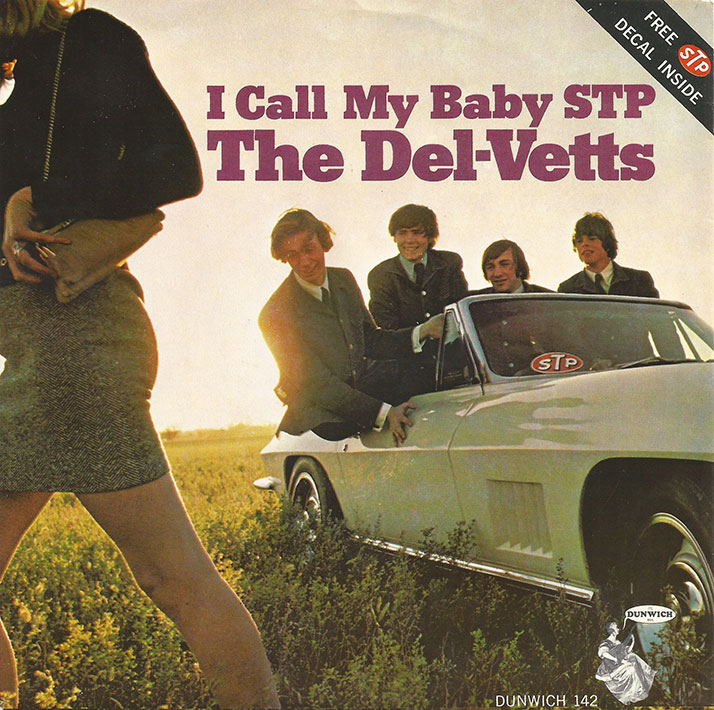
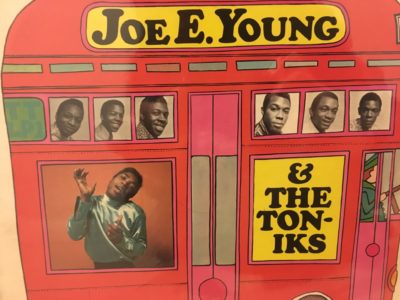 Colin Young – lead vocals
Colin Young – lead vocals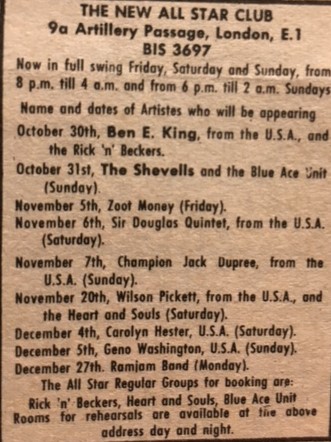
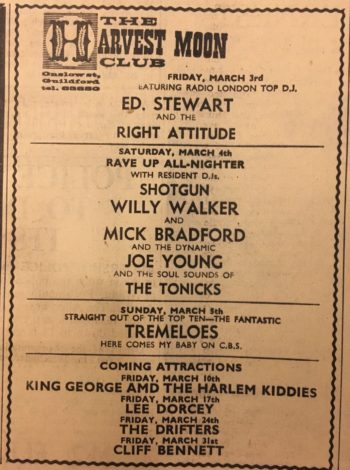
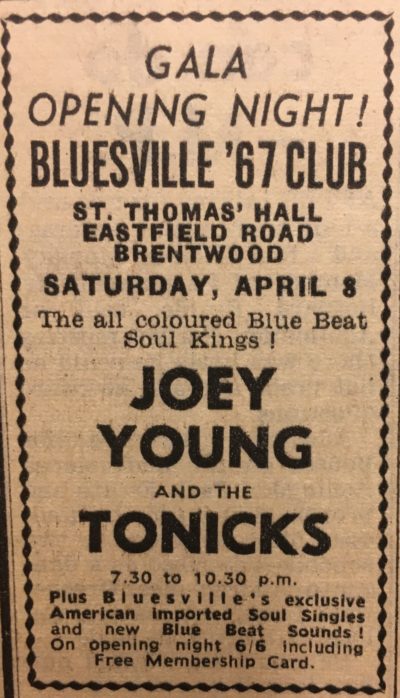








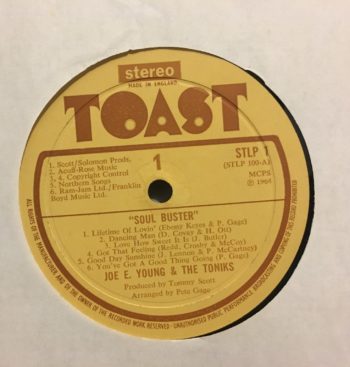 Two of the earliest tracks to be recorded were two Pete Gage songs, co-written with Ebony Keyes (aka Kenrick Pitt), “Lifetime of Lovin’” c/w “Flower In My Hand”. Paired as a single, the tracks were issued on Toast in January 1968 but did not chart. Incidentally, the single also saw a South African release on the Continental label.
Two of the earliest tracks to be recorded were two Pete Gage songs, co-written with Ebony Keyes (aka Kenrick Pitt), “Lifetime of Lovin’” c/w “Flower In My Hand”. Paired as a single, the tracks were issued on Toast in January 1968 but did not chart. Incidentally, the single also saw a South African release on the Continental label.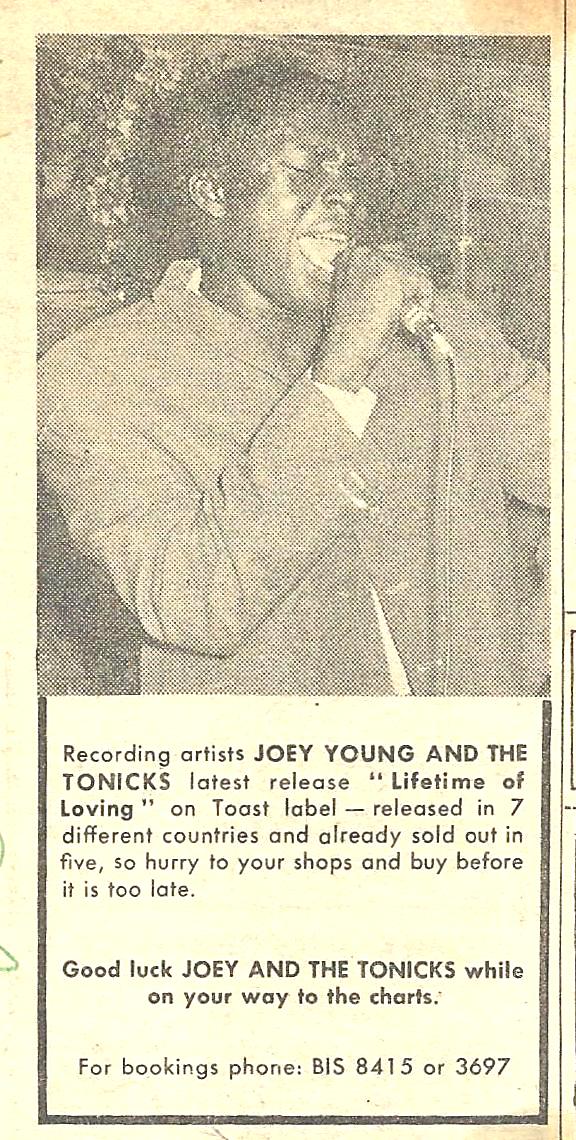















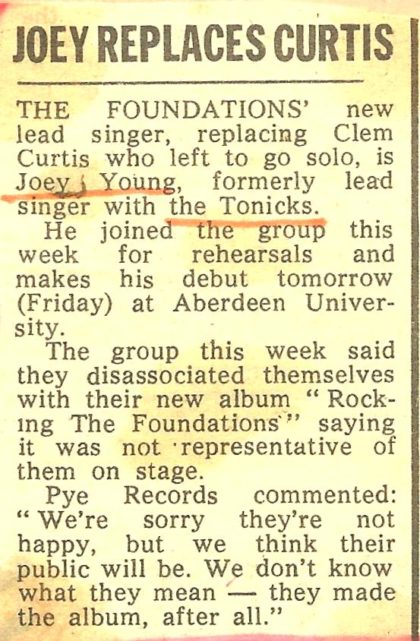
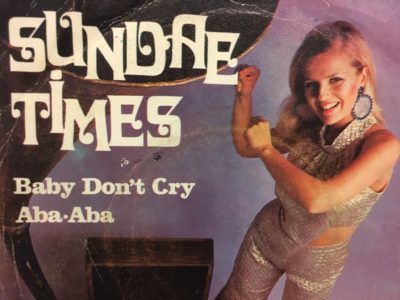 Wendell Richardson – guitar/vocals
Wendell Richardson – guitar/vocals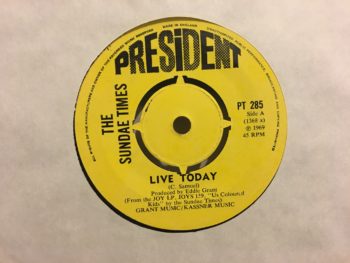 With The Sundae Times starting to pick up gigs and with further hits potentially in the pipeline, Conrad Isidore left The Toniks around September 1968 to commit to the project full-time. In retrospect, it was a sensible move as singer Colin Young quit The Toniks soon after to join British hit-makers, The Foundations.
With The Sundae Times starting to pick up gigs and with further hits potentially in the pipeline, Conrad Isidore left The Toniks around September 1968 to commit to the project full-time. In retrospect, it was a sensible move as singer Colin Young quit The Toniks soon after to join British hit-makers, The Foundations.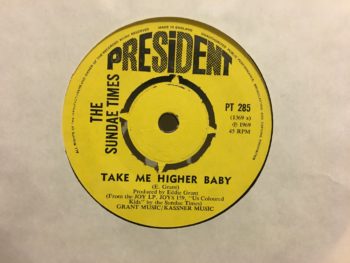 The three musicians also collaborated on three other tracks on the LP, “Take Me Back Again”, “Psychedelic Dream” and “Do You Know What Love Is”. Samuel meanwhile penned two tracks, “On The Run” and “Live Today”, which belatedly headed up The Sundae Times’ final single outing (issued on 13 March 1970), and was coupled with Eddy Grant’s “Take Me Higher Baby”.
The three musicians also collaborated on three other tracks on the LP, “Take Me Back Again”, “Psychedelic Dream” and “Do You Know What Love Is”. Samuel meanwhile penned two tracks, “On The Run” and “Live Today”, which belatedly headed up The Sundae Times’ final single outing (issued on 13 March 1970), and was coupled with Eddy Grant’s “Take Me Higher Baby”.


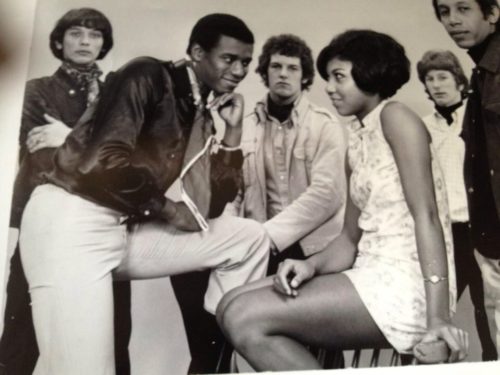
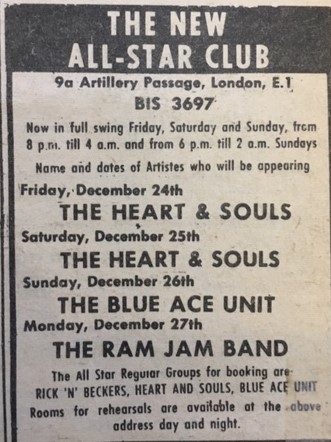
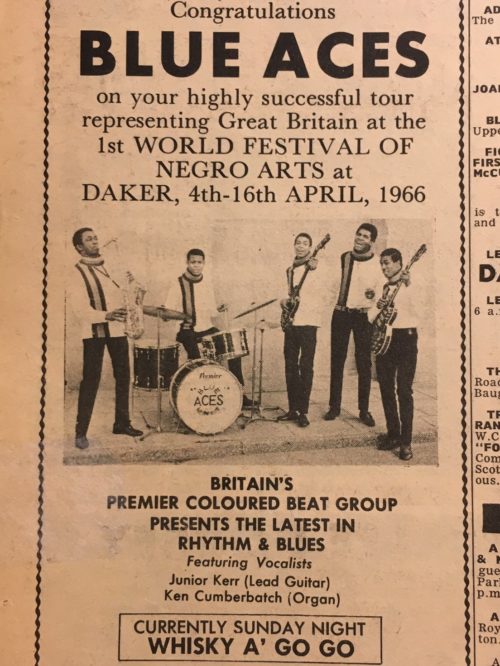
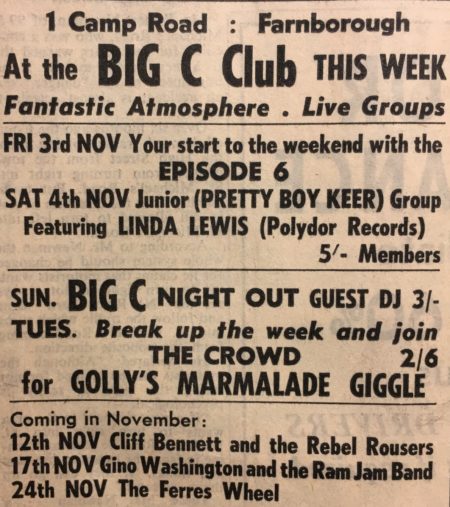 In July 1967, Polydor Records had issued Linda Lewis’ debut solo single, “You Turned My Bitter Into Sweet” but it had not been a chart success.
In July 1967, Polydor Records had issued Linda Lewis’ debut solo single, “You Turned My Bitter Into Sweet” but it had not been a chart success.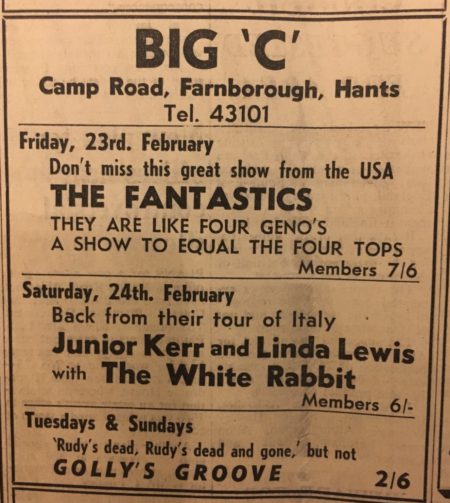 Managed by Ian Samwell (Lewis’ manager) and Laurie O’Leary who managed the Speakeasy, the group played a month’s residency in Biarritz, the south of France, at the Canasta Club. Then, in the early months of 1968, White Rabbit toured Italy and France, but after their return (around late March), Kerr decided to leave.
Managed by Ian Samwell (Lewis’ manager) and Laurie O’Leary who managed the Speakeasy, the group played a month’s residency in Biarritz, the south of France, at the Canasta Club. Then, in the early months of 1968, White Rabbit toured Italy and France, but after their return (around late March), Kerr decided to leave.
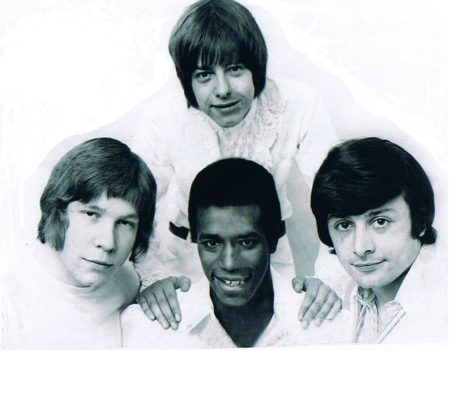


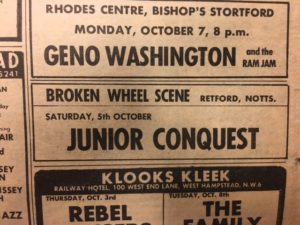
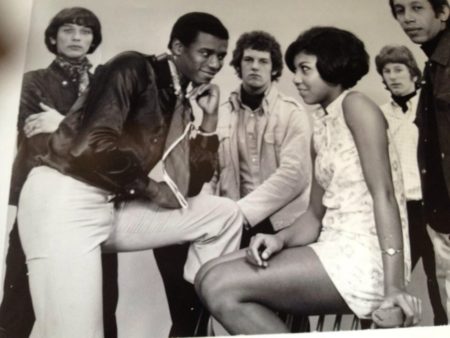
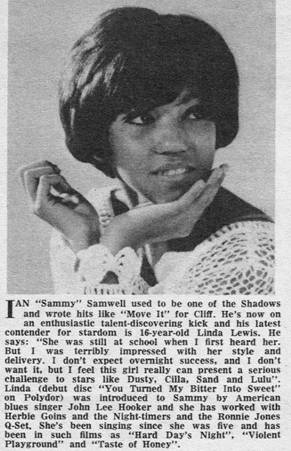
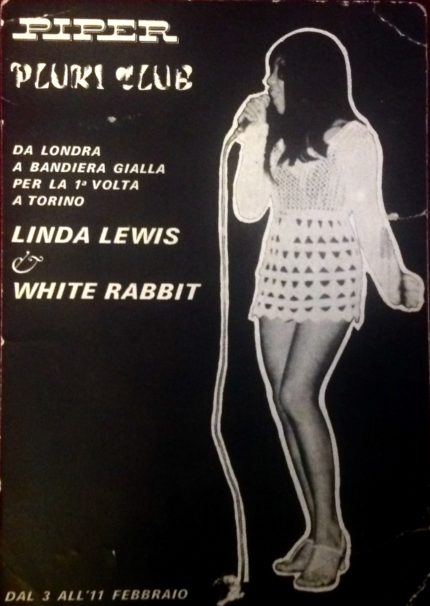 The original version of White Rabbit was completed with two additional musicians, rhythm guitarist/singer Brian Henderson, who’d recently been part of Nirvana’s backing band and was previously in The Soul Mates and Liza Strike & The Jet Set, and bass player Ralph Richardson, who’d worked with Henderson in The Jet Set.
The original version of White Rabbit was completed with two additional musicians, rhythm guitarist/singer Brian Henderson, who’d recently been part of Nirvana’s backing band and was previously in The Soul Mates and Liza Strike & The Jet Set, and bass player Ralph Richardson, who’d worked with Henderson in The Jet Set.


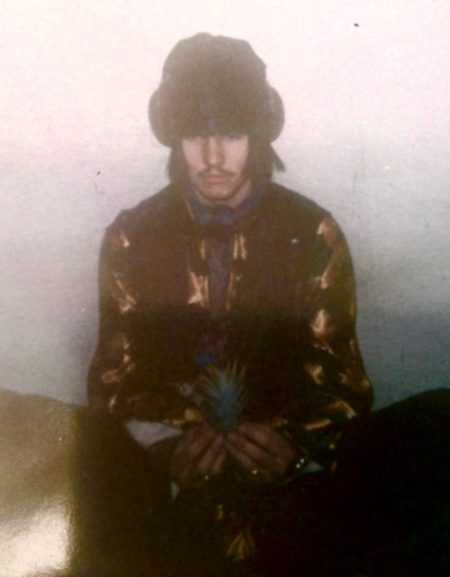
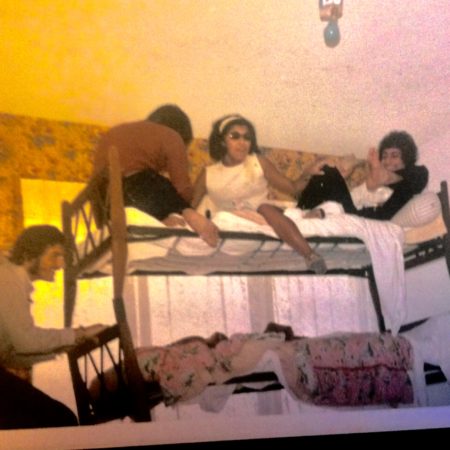
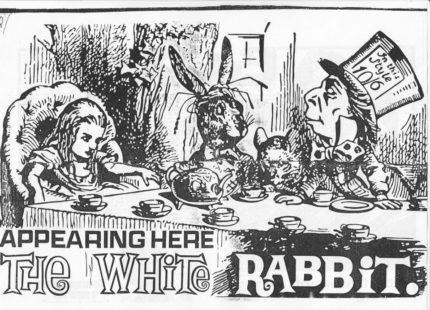 Around August/September 1968, however, Rod Goodway and Linda Lewis both left, the latter to embark on a successful solo career after fronting Ferris Wheel where she played alongside future Foreigner drummer Dennis Elliott.
Around August/September 1968, however, Rod Goodway and Linda Lewis both left, the latter to embark on a successful solo career after fronting Ferris Wheel where she played alongside future Foreigner drummer Dennis Elliott.